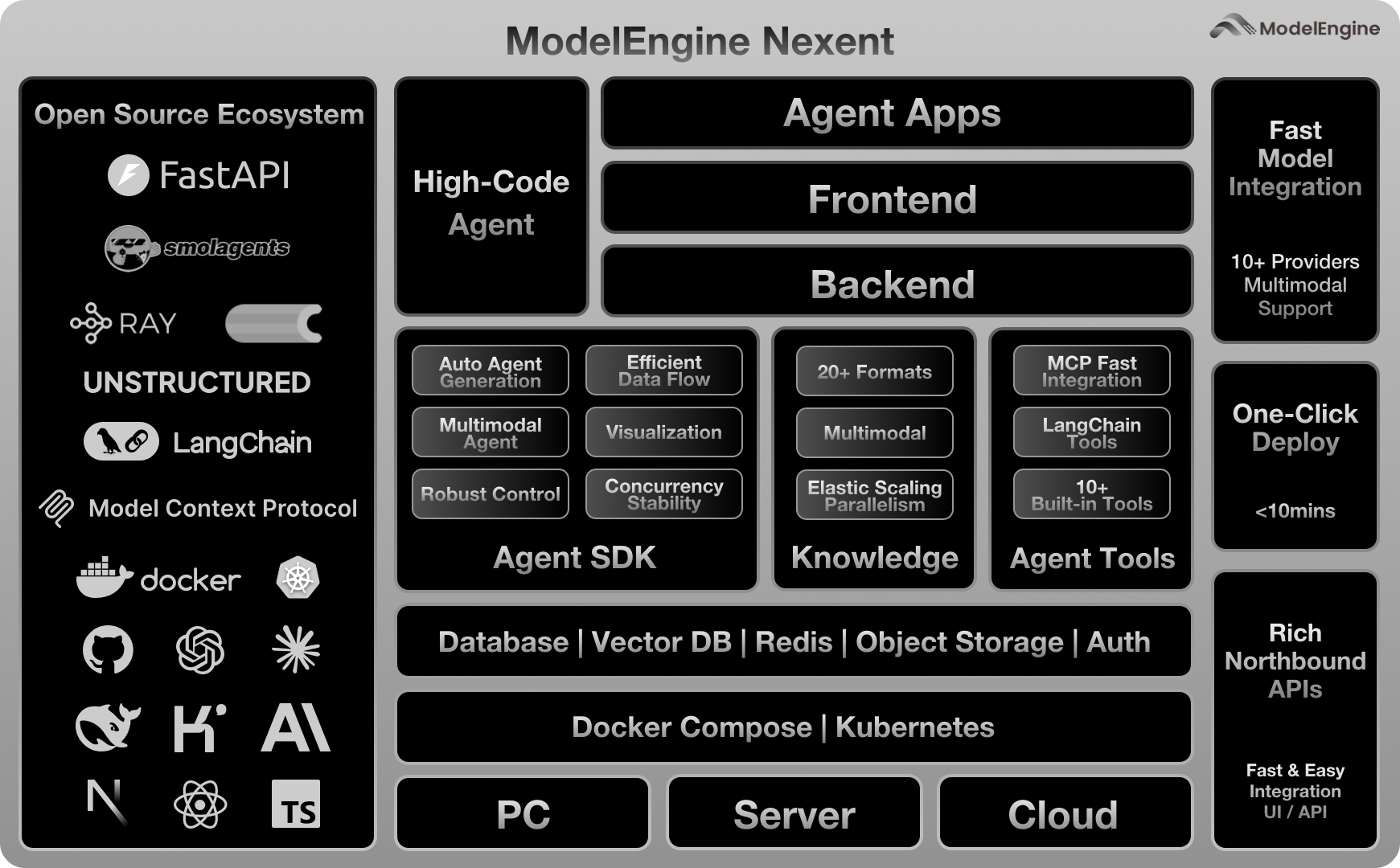Software Architecture
Nexent adopts a modern distributed microservices architecture designed to provide high-performance, scalable AI agent platform. The entire system is based on containerized deployment, supporting cloud-native and enterprise-grade application scenarios.

🏗️ Overall Architecture Design
Nexent's software architecture follows layered design principles, structured into the following core layers from top to bottom:
🌐 Frontend Layer
- Technology Stack: Next.js + React + TypeScript
- Functions: User interface, agent interaction, multimodal input processing
- Features: Responsive design, real-time communication, internationalization support
🔌 API Gateway Layer
- Core Service: FastAPI high-performance web framework
- Responsibilities: Request routing, authentication, API version management, load balancing
- Ports: 5010 (main service), 5012 (data processing service)
🧠 Business Logic Layer
- Agent Management: Agent generation, execution, monitoring
- Conversation Management: Multi-turn dialogue, context maintenance, history tracking
- Knowledge Base Management: Document processing, vectorization, retrieval
- Model Management: Multi-model support, health checks, load balancing
📊 Data Layer
Distributed data storage architecture with multiple specialized databases:
🗄️ Structured Data Storage
- PostgreSQL: Primary database storing user information, agent configurations, conversation records
- Port: 5434
- Features: ACID transactions, relational data integrity
🔍 Search Engine
- Elasticsearch: Vector database and full-text search engine
- Port: 9210
- Functions: Vector similarity search, hybrid search, large-scale optimization
💾 Cache Layer
- Redis: High-performance in-memory database
- Port: 6379
- Usage: Session caching, temporary data, distributed locks
📁 Object Storage
- MinIO: Distributed object storage service
- Port: 9010
- Functions: File storage, multimedia resource management, large file processing
🔧 Core Service Architecture
🤖 Agent Services
Agent framework based on SmolAgents, providing:
├── Agent generation and configuration
├── Tool calling and integration
├── Reasoning and decision execution
└── Lifecycle management📈 Data Processing Services
Distributed data processing architecture:
├── Real-time document processing (20+ format support)
├── Batch data processing pipelines
├── OCR and table structure extraction
└── Vectorization and index construction🌐 MCP Ecosystem
Model Context Protocol tool integration:
├── Standardized tool interfaces
├── Plugin architecture
├── Third-party service integration
└── Custom tool development🚀 Distributed Architecture Features
⚡ Asynchronous Processing Architecture
- Foundation Framework: High-performance async processing based on asyncio
- Concurrency Control: Thread-safe concurrent processing mechanisms
- Task Queue: Celery + Ray distributed task execution
- Stream Processing: Real-time data and response streaming
🔄 Microservices Design
Service decomposition strategy:
├── nexent (main service) - Agent core logic
├── nexent-data-process (data processing) - Document processing pipeline
├── nexent-mcp-service (MCP service) - Tool protocol service
└── Optional services (SSH, monitoring, etc.)🌍 Containerized Deployment
Docker Compose service orchestration:
├── Application service containerization
├── Database service isolation
├── Network layer security configuration
└── Volume mounting for data persistence🔐 Security and Scalability
🛡️ Security Architecture
- Authentication: Multi-tenant support, user permission management
- Data Security: End-to-end encryption, secure transmission protocols
- Network Security: Inter-service secure communication, firewall configuration
📈 Scalability Design
- Horizontal Scaling: Independent microservice scaling, load balancing
- Vertical Scaling: Resource pool management, intelligent scheduling
- Storage Scaling: Distributed storage, data sharding
🔧 Modular Architecture
- Loose Coupling Design: Low inter-service dependencies, standardized interfaces
- Plugin Architecture: Hot-swappable tools and models
- Configuration Management: Environment isolation, dynamic configuration updates
🔄 Data Flow Architecture
📥 User Request Flow
User Input → Frontend Validation → API Gateway → Route Distribution → Business Service → Data Access → Database🤖 Agent Execution Flow
User Message → Agent Creation → Tool Calling → Model Inference → Streaming Response → Result Storage📚 Knowledge Base Processing Flow
File Upload → Temporary Storage → Data Processing → Vectorization → Knowledge Base Storage → Index Update⚡ Real-time Processing Flow
Real-time Input → Instant Processing → Agent Response → Streaming Output🎯 Architecture Advantages
🏢 Enterprise-grade Features
- High Availability: Multi-layer redundancy, failover capabilities
- High Performance: Asynchronous processing, intelligent caching
- High Concurrency: Distributed architecture, load balancing
- Monitoring Friendly: Comprehensive logging and status monitoring
🔧 Developer Friendly
- Modular Development: Clear hierarchical structure
- Standardized Interfaces: Unified API design
- Flexible Configuration: Environment adaptation, feature toggles
- Easy Testing: Unit testing and integration testing support
🌱 Ecosystem Compatibility
- MCP Standard: Compliant with Model Context Protocol
- Open Source Ecosystem: Integration with rich open source tools
- Cloud Native: Support for Kubernetes and Docker deployment
- Multi-model Support: Compatible with mainstream AI model providers
This architectural design ensures that Nexent can provide a stable, scalable AI agent service platform while maintaining high performance. Whether for individual users or enterprise-level deployments, it delivers excellent user experience and technical assurance.
